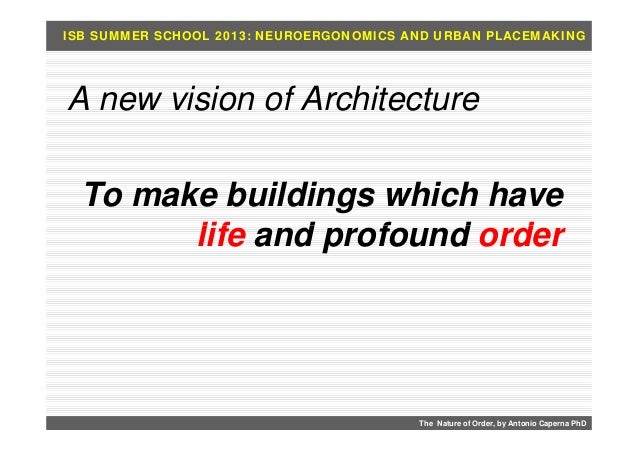A New Theory Of Urban Design Christopher Alexander Pdf Editor

The venerable cities of the past, such as Venice or Amsterdam, convey a feeling of wholeness, an organic unity that surfaces in every detail, large and small, in restaurants, shops, public gardens, even in balconies and ornaments. But this sense of wholeness is lacking in modern urban design, with architects absorbed in problems of individual structures, and city planners preoccupied with local ordinances, it is almost impossible to achieve. In this groundbreaking volume, architect and planner Christopher Alexander presents a new theory of urban design which attempts to recapture the process by which cities develop organically.
Christopher Alexander's work at the PURPLSOC preparatory workshop, is the first. “A Bird's-Eye View on Pattern Research” draws an overall picture of the new. Design studios, courses, and seminars in urban architecture and theory with an emphasis.
To discover the kinds of laws needed to create a growing whole in a city, Alexander proposes here a preliminary set of seven rules which embody the process at a practical level and which are consistent with the day-to-day demands of urban development. Viskazivaniya sari alpisovni. He then puts these rules to the test, setting out with a number of his graduate students to simulate the urban redesign of a high-density part of San Francisco, initiating a project that encompassed some ninety different design problems, including warehouses, hotels, fishing piers, a music hall, and a public square.
This extensive experiment is documented project by project, with detailed discussion of how each project satisfied the seven rules, accompanied by floorplans, elevations, street grids, axonometric diagrams and photographs of the scaled-down model which clearly illustrate the discussion. A New Theory of Urban Design provides an entirely new theoretical framework for the discussion of urban problems, one that goes far to remedy the defects which cities have today.
• 5.6k Downloads • Abstract A Pattern Language by Christopher Alexander is renowned for providing simple, conveniently formatted, humanist solutions to complex design problems ranging in scale from urban planning through to interior design. This text is also believed to be the most widely read architectural treatise ever published.
Despite this, there is also little acknowledgement in its popular reception that it is only one part of a trilogy of works documenting Alexander’s ‘second theory’ of architecture. Serial processing operating system. Thus, while A Pattern Language is widely referenced in architectural scholarship, most of these references simply acknowledge its existence and fail to engage with its content. Furthermore, the literature that does critically engage with Alexander’s theory, challenging its ideas and assumptions, is often difficult to find, and the criticisms are diverse and complex. The intent of this paper is to facilitate a deeper understanding of these criticisms and the relationships between them.
The 28 criticisms identified in past research are organised hierarchically in this paper into three tiers representing those associated with the: (i) conceptualisation, (ii) development and documentation and, (iii) implementation and outcomes of Alexander’s theory. The relationships between these criticisms are then mapped diagrammatically thereby forming the basis for thematic groupings within each hierarchical tier. This organisation reveals that only two criticisms relate to the concept of pattern languages in isolation, while the remainder arise, directly or indirectly, from Alexander’s idiosyncratic ontological and epistemological positions. The conclusion analyses the relationships between the criticisms to develop a holistic and understanding of where the problems in Alexander’s theory might lie. Massive social, technical and economic changes during the nineteenth century provided the catalyst for the rise of modernism in architecture, and the creation of some of the world’s most iconic buildings. However, the relentless pursuit of the modernist aesthetic also produced examples of uncomfortable and inhospitable spaces. Christopher Alexander was amongst the most vocal critics of these spaces and responded to them by devoting his career to developing three unique and closely related theories of architectural and urban design.
This paper focuses on Alexander’s ‘second theory’ of architecture, which appeared in the form of three canonical texts, The Timeless Way of Building (Alexander ), A Pattern Language (Alexander et al. ), and the Oregon Experiment (Alexander et al. It must be noted that Alexander’s research actually constitutes a single, slowly evolving theory of architecture that spans his entire career. However, these three texts represent a stable, middle stage in Alexander’s research and collectively provide a sufficiently self-contained set of ideas to be described (for the ease of the following discussion) as his ‘second theory’. Alexander’s second theory is significant for its attempt to facilitate a paradigm shift in architecture that would replace the conventional, subjective and explanatory, theory with an objective, evidence-based, theory that directly generates a design (Grabow; Gelernter ). A Pattern Language is significant for demystifying complex socio-spatial considerations through a simple building block format which makes this content accessible to non-professionals, and is one reason why this text is believed to be the most widely read architectural treatise ever published (Lea; Alexander; Kohn; Saunders; Hermann; Mehaffy; Silva and Paraizo ).